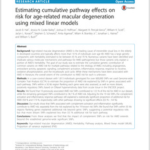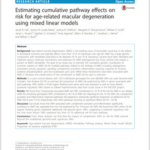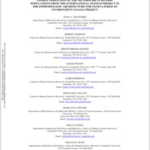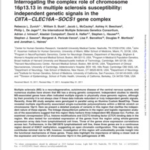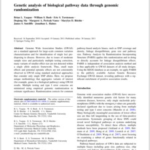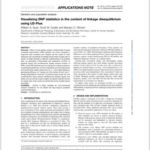Hall JB, Cooke Bailey JN, Hoffman JD, Pericak-Vance MA, Scott WK, Kovach JL, Schwartz SG, Agarwal A, Brantley MA, Haines JL, Bush WS,. Age-related macular degeneration (AMD) is the leading cause of irreversible visual loss in the elderly in developed countries and typically affects more than 10% of individuals over age 80. AMD has a […]
Tag Archives: Linkage Disequilibrium
Estimating cumulative pathway effects on risk for age-related macular degeneration using mixed linear models.
Age-related macular degeneration (AMD) is the leading cause of irreversible visual loss in the elderly in developed countries and typically affects more than 10% of individuals over age 80. AMD has a large genetic component, with heritability estimated to be between 45% and 70%. Numerous variants have been identified and implicate various molecular mechanisms and […]
Estimating cumulative pathway effects on risk for age-related macular degeneration using mixed linear models.
Age-related macular degeneration (AMD) is the leading cause of irreversible visual loss in the elderly in developed countries and typically affects more than 10% of individuals over age 80. AMD has a large genetic component, with heritability estimated to be between 45% and 70%. Numerous variants have been identified and implicate various molecular mechanisms and […]
Estimating cumulative pathway effects on risk for age-related macular degeneration using mixed linear models.
Hall JB, Cooke Bailey JN, Hoffman JD, Pericak-Vance MA, Scott WK, Kovach JL, Schwartz SG, Agarwal A, Brantley MA, Haines JL, Bush WS,. Age-related macular degeneration (AMD) is the leading cause of irreversible visual loss in the elderly in developed countries and typically affects more than 10% of individuals over age 80. AMD has a […]
Characterization of the Metabochip in diverse populations from the International HapMap Project in the Epidemiologic Architecture for Genes Linked to Environment (EAGLE) project.
Genome-wide association studies (GWAS) have identified hundreds of genomic regions associated with common human disease and quantitative traits. A major research avenue for mature genotype-phenotype associations is the identification of the true risk or functional variant for downstream molecular studies or personalized medicine applications. As part of the Population Architecture using Genomics and Epidemiology (PAGE) […]
Characterization of the Metabochip in diverse populations from the International HapMap Project in the Epidemiologic Architecture for Genes Linked to Environment (EAGLE) project.
Crawford DC, Goodloe R, Brown-Gentry K, Wilson S, Roberson J, Gillani NB, Ritchie MD, Dilks HH, Bush WS,. Genome-wide association studies (GWAS) have identified hundreds of genomic regions associated with common human disease and quantitative traits. A major research avenue for mature genotype-phenotype associations is the identification of the true risk or functional variant for […]
Interrogating the complex role of chromosome 16p13.13 in multiple sclerosis susceptibility: independent genetic signals in the CIITA-CLEC16A-SOCS1 gene complex.
Multiple sclerosis (MS) is a neurodegenerative, autoimmune disease of the central nervous system, and numerous studies have shown that MS has a strong genetic component. Independent studies to identify MS-associated genes have often indicated multiple signals in physically close genomic regions, although by their proximity it is not always clear if these data indicate redundant […]
Interrogating the complex role of chromosome 16p13.13 in multiple sclerosis susceptibility: independent genetic signals in the CIITA-CLEC16A-SOCS1 gene complex.
Zuvich RL, Bush WS, McCauley JL, Beecham AH, De Jager PL, , Ivinson AJ, Compston A, Hafler DA, Hauser SL, Sawcer SJ, Pericak-Vance MA, Barcellos LF, Mortlock DP, Haines JL,. Multiple sclerosis (MS) is a neurodegenerative, autoimmune disease of the central nervous system, and numerous studies have shown that MS has a strong genetic component. […]
Genetic analysis of biological pathway data through genomic randomization.
Genome Wide Association Studies (GWAS) are a standard approach for large-scale common variation characterization and for identification of single loci predisposing to disease. However, due to issues of moderate sample sizes and particularly multiple testing correction, many variants of smaller effect size are not detected within a single allele analysis framework. Thus, small main effects […]
Genetic analysis of biological pathway data through genomic randomization.
Yaspan BL, Bush WS, Torstenson ES, Ma D, Pericak-Vance MA, Ritchie MD, Sutcliffe JS, Haines JL,. Genome Wide Association Studies (GWAS) are a standard approach for large-scale common variation characterization and for identification of single loci predisposing to disease. However, due to issues of moderate sample sizes and particularly multiple testing correction, many variants of […]
Visualizing SNP statistics in the context of linkage disequilibrium using LD-Plus.
Often in human genetic analysis, multiple tables of single nucleotide polymorphism (SNP) statistics are shown alongside a Haploview style correlation plot. Readers are then asked to make inferences that incorporate knowledge across these multiple sets of results. To better facilitate a collective understanding of all available data, we developed a Ruby-based web application, LD-Plus, to […]
Visualizing SNP statistics in the context of linkage disequilibrium using LD-Plus.
Bush WS, Dudek SM, Ritchie MD,. Often in human genetic analysis, multiple tables of single nucleotide polymorphism (SNP) statistics are shown alongside a Haploview style correlation plot. Readers are then asked to make inferences that incorporate knowledge across these multiple sets of results. To better facilitate a collective understanding of all available data, we developed […]

